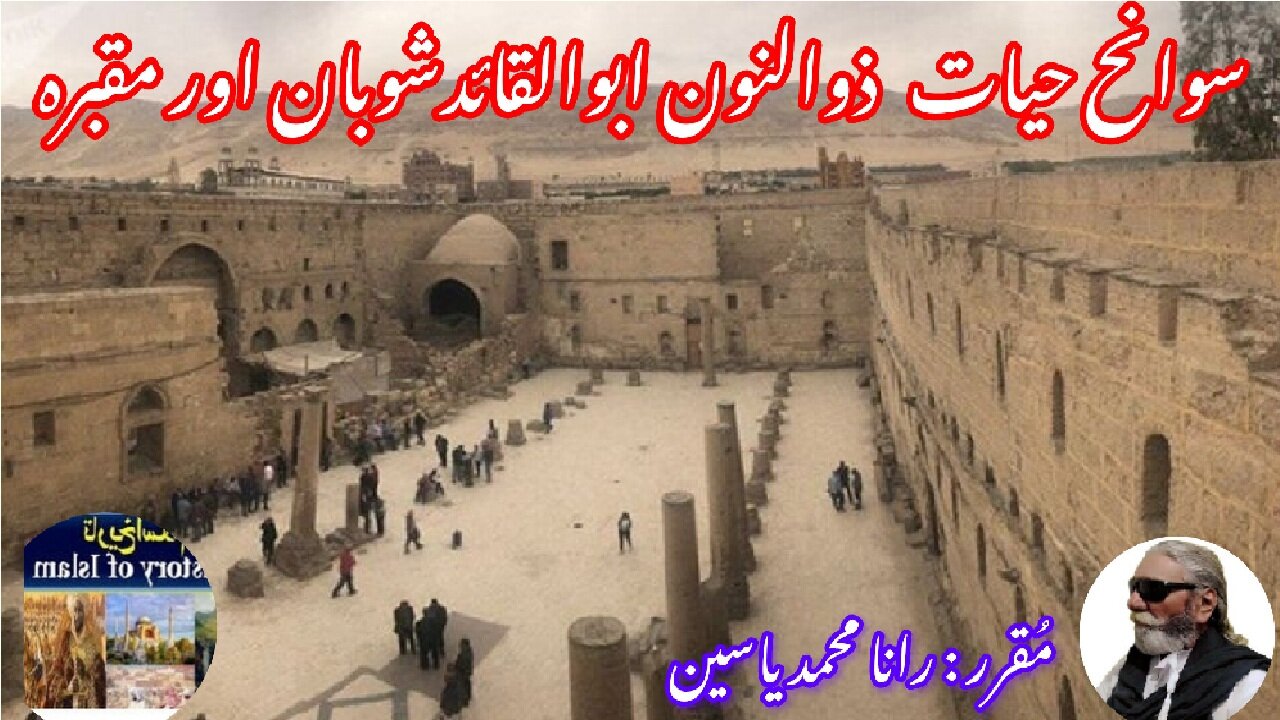Premium Only Content

Dhul-Nun Abu l-Fayd Thawban धुल-नून अबू अल-फ़यद ذوالنون ابو الفائد ثوبان کی سوانح عمری اور مزار
@islamichistory813 #sufisaint #culturalheritage #biography #dhulnun #abualfayd #thawban #islamicmysticism #zulnun #almisri #islamicphilosophy #shrine #historicalfigures
Biography of Dhul-Nun Abu al-Fayd Thawban and the history of his shrine.
Dekhti Aankhooon aur sountay kaanoon ko Asslamoalaikum, sisters, brothers friends and elders, in informative series videos of Islamic ascolars, sufisaints, cultural heritages, islamic philosophys, islamic mysticisms and historical figures. today we are describing biography of Dhul-Nun Abu l-Fayd Thawban and the history of his shrine.
Dhul-Nun Abu l-Fayd Thawban often referred to Zul-Nun al-Misri for short, was an early Egyptian Muslim mystic and ascetic His surname "al Misri" means "The Egyptian". He was born in Akhmim, Upper Egypt in 796 and is said to be of Nubian descent. Dhul-Nun is said to have made some study of the scholastic disciplines of alchemy, medicine, and Greek philosophy in his early life, before coming under the mentorship of the mystic Sadun of Cairo, who is described in traditional accounts of Dhul-Nun's life as both "his teacher and spiritual director." Celebrated for his legendary wisdom both in his own life and by later Islamic thinkers, Dhul-Nun has been venerated in traditional Sunni Islam as one of the greatest saints of the early era of Sufism.
It has been speculated by scholars whether "Dhul-Nun" was an honorific (laqab) for the mystic rather than his name proper, which is sometimes believed to be Thawban. As "Dhul-Nun," literally meaning "the one of the fish [or whale]," is another name for the Hebrew prophet Jonah in Islamic tradition, it is sometimes believed that this title was given to Dhul-Nun in commemoration of Jonah.
Dhul-Nun is one of the most prominent saints of early Islamic tradition, appearing "in the earliest accounts of sufism as the leading figure of his generation." Often depicted as the spiritual master of Sahl al-Tustari, the traditional hagiographies relate that the latter refused to engage in mystical discourse until after Dhul-Nun's death, on account of his recognition of Dhul-Nun's elevated rank in wisdom and gnosis.
Dhul-Nun al-Misri is considered among the most prominent saints of early Sufism and holds a position in the Sufi chronicles as high as Junayd Baghdadi and Bayazid Bastami. He studied under various teachers and travelled extensively in Arabia and Syria. The Muslim scholar and Sufi Sahl al-Tustari was one of Dhul-Nun al-Misri's students. In 829 he was arrested on a charge of heresy and sent to prison in Baghdad, but after examination he was released on the caliph's orders to return to Cairo, where he died in 859; his tombstone has been preserved.
Dhul-Nun's name came about in relation to an incident on a sea voyage. He was falsely accused of stealing a jewel from a merchant. He cried out "O Creator, Thou knowest best", whereupon a large number of fish raised their heads above the waves, each bearing a jewel in its mouth.
A legendary alchemist and thaumaturge, he is supposed to have known the secret of the Egyptian hieroglyphs. His sayings and poems, which are extremely dense and rich in mystical imagery, emphasize knowledge or gnosis (marifah) more than fear (makhafah) or love (mahabbah), the other two major paths of spiritual realization in Sufism. None of his written works have survived, but a vast collection of poems, sayings, and aphorisms attributed to him continues to live on in oral tradition.
Osho mentions him as "an Egyptian Sufi mystic, one of the greatest who has ever walked on the earth".
Contemporary Sufi Llewellyn Vaughan-Lee mentions an incident from the life of Dhul-nun in his work Catching the Thread:
A story from the life of the ninth-century Sufi, Dhu-l-Nun, the Egyptian, illustrates this:
I was wandering in the mountains when I observed a party of afflicted folk gathered together. "What befell you?" I asked.
"There is a devotee living in a cell here," they answered. "Once every year he comes out and breathes on these people and they are all healed. Then he returns to his cell, and does not emerge again until the following year."
I waited patiently until he came out. I beheld a man pale of cheek, wasted and with sunken eyes. The awe of him caused me to tremble. He looked on the multitude with compassion. Then he raised his eyes to heaven, and breathed several times over the afflicted ones. All were healed.
As he was about to retire to his cell, I seized his skirt. "For the love of God," I cried. "You have healed the outward sickness; pray heal the inward sickness."
"Dhu-l-Nun," he said, gazing at me, "take your hand off me. The Friend is watching from the zenith of might and majesty. If He sees you clutching at another than He, He will abandon you to that person, and that person to you, and you will perish each at the other’s hand."
Dhul-Nun Abu l-Fay? Thawban, commonly known as Dhul-Nun al-Misri, was a famous Islamic mystic, philosopher, and one of the earliest figures in the development of Sufism. He was born in Egypt during the late 8th century and played a crucial role in the evolution of Islamic mysticism. While much of his life is shrouded in mystery, Dhul-Nun’s death, his legacy, and the shrine built in his honor have remained focal points for those interested in the history of Islamic spirituality. His contributions to Islamic thought, especially the integration of mysticism with Islamic theology, marked him as one of the most important early figures in Sufism.
Dhul-Nun Abu l-Fay? Thawban died around 860 CE, though the exact year remains a subject of debate. Scholars generally agree that he passed away in Upper Egypt, specifically in the region of Asyut, though some sources suggest he may have died in another part of Egypt. During his lifetime, Dhul-Nun was revered for his deep spiritual insights, which combined elements of the Qur’an, Hadith, and the burgeoning Sufi tradition. He became widely known as one of the first mystics to articulate the experiential aspects of the Divine, emphasizing the inner dimensions of worship and the importance of seeking God through personal, mystical experience. His teachings laid the foundation for later Sufi philosophers and mystics, especially in how they viewed the nature of the soul, divine love, and the path to enlightenment.
While Dhul-Nun's death may have occurred more than a millennium ago, his influence as a philosopher and mystic continued to reverberate long after his passing. His death marked the end of his active contributions to the spiritual life of the Islamic world, but his teachings and writings endured through generations, influencing key figures in Sufism, including those in the later centuries of the Abbasid and Ottoman periods.
Dhul-Nun’s tomb and shrine are located in the city of Asyut, which is situated in Upper Egypt along the Nile River. Asyut has long been a city of significance in Islamic Egypt, known for its religious institutions, intellectual centers, and its association with many great scholars and mystics. The exact location of Dhul-Nun's shrine in Asyut has become an important pilgrimage site for Muslims interested in Sufism and Islamic mysticism. His tomb in Asyut stands as a testament to his enduring legacy as a key figure in the development of Islamic spirituality.
While the shrine itself has undergone several renovations over the centuries, it remains an essential place for followers of Sufism and others who admire Dhul-Nun's life and teachings. The shrine attracts worshippers and visitors who come to pay their respects to the mystic and philosopher. Over the centuries, it has become a site of spiritual reflection and a destination for those seeking to honor the memory of Dhul-Nun, who is revered not only as a scholar but also as a spiritual guide.
The shrine is not just a physical site but a spiritual landmark where pilgrims gather to reflect on Dhul-Nun’s teachings, many of which focus on divine love, the purification of the heart, and the importance of mystical experience. Visitors often engage in prayer, recite his sayings, and reflect on his writings, which emphasize the transformative power of God’s presence in the human soul. Dhul-Nun’s influence in Sufism is deeply felt at this shrine, making it a significant part of the broader Sufi tradition.
The construction and maintenance of Dhul-Nun’s shrine in Asyut were likely undertaken by his followers and later generations who venerated him as one of the early masters of Islamic mysticism. The shrine's origins are somewhat unclear, but it is believed that it was initially constructed soon after his death, as with many other early Islamic figures who were honored with tombs and shrines. The importance of shrines in Islam, particularly for revered scholars and mystics, became more pronounced in the centuries following Dhul-Nun’s passing. These shrines not only served as final resting places but also as symbols of the continuing influence of the mystic’s teachings.
The initial construction of the shrine may have been modest, as it was common for early Islamic scholars and mystics to be buried in simple graves. However, over time, as Dhul-Nun’s fame as a spiritual guide and teacher grew, the shrine likely underwent renovations and expansion. These improvements would have been made by later generations of his followers, who felt a strong connection to Dhul-Nun’s teachings and wanted to preserve his memory. The shrine’s development reflects the growing reverence for him in the Sufi tradition, which gained significant momentum in the centuries after his death.
It is likely that the shrine was expanded during the Abbasid period or possibly later during the Fatimid or Mamluk periods, when Sufism became more institutionalized, and the veneration of saints and scholars became a more widespread practice. During these periods, many Sufi orders grew in influence, and the construction of tombs and shrines for revered figures like Dhul-Nun became increasingly common. The Ottoman Empire also played a significant role in the renovation and protection of such religious sites during its rule over Egypt, contributing to the further development of the shrine and its role as a site of pilgrimage.
While the specific individuals or groups responsible for the shrine’s construction are not definitively known, it is safe to assume that it was a collective effort of Dhul-Nun’s followers, local religious leaders, and political authorities who sought to honor his memory. These acts of veneration were often motivated by a desire to preserve the mystic’s teachings and to create a physical space for spiritual reflection and connection.
Dhul-Nun al-Misri’s shrine remains an important site of religious and spiritual significance in Egypt and for the broader Muslim world. Today, the shrine is visited by many people, not only those interested in the history of Sufism but also those who are drawn to Dhul-Nun’s teachings on asceticism, divine love, and the inner journey to God. The shrine serves as a place for prayer, reflection, and connection to the legacy of one of Islam’s most influential early mystics.
Over the centuries, the shrine has become a focal point for Sufi practices and gatherings. Pilgrims come to honor Dhul-Nun’s memory and to seek blessings, and the shrine is frequently visited by those who follow the Sufi path, as well as scholars and individuals interested in the mystical dimensions of Islam. The shrine has, therefore, remained a vibrant center of spiritual activity and continues to be an enduring symbol of Dhul-Nun’s influence on Islamic mysticism.
The shrine has been maintained and expanded over the centuries by his followers and later generations who revered him as a spiritual guide. While the exact details of its construction are unclear, it is clear that the shrine has been a site of pilgrimage for those seeking to honor Dhul-Nun’s teachings and to reflect on the mystical path he charted. Today, the shrine continues to serve as a focal point for those drawn to the teachings of one of Islam's most beloved early mystics, preserving his memory and his teachings for future generations.
With that allow us until tomorrow, tomorrow we will be described biography of Islamic Scholar Sufi Sanit Fakhr al-Din al-Razi and the history of his shrine.
================================================
-
 12:41
12:41
Gun Owners Of America
1 hour agoWe're Fighting Back Against Mexico In Court!
821 -
 LIVE
LIVE
The Charlie Kirk Show
2 hours agoThe CR Quagmire + An Hour of PBD + Catholic in Hollywood | Davis, Patrick Bet David, Rep. Burlison
7,952 watching -
 32:54
32:54
Kicking Mustang
7 hours ago $0.02 earnedWatch the Best Ghillie Sniper Moments of 2024...
61 -
 49:34
49:34
PMG
14 hours ago"Hannah Faulkner and Ron Berutti | NEW SUPREME COURT CASES"
476 -
 28:29
28:29
The Boomer Effect
14 hours agoPondering Life in Modern America
20 -
 1:01:44
1:01:44
Grant Stinchfield
2 hours ago $2.09 earnedDon't Focus on the Drones... Focus on the Mysterious Floating Orbs!
13.3K2 -
 LIVE
LIVE
The Dana Show with Dana Loesch
2 hours agoSPENDING BATTLE COUNTDOWN | The Dana Show LIVE On Rumble!
536 watching -
 59:38
59:38
The Dan Bongino Show
4 hours agoThings Have Changed, It's Trump's GOP Now (Ep. 2390) - 12/18/2024
559K1.2K -
 LIVE
LIVE
Viss
2 hours ago🔴LIVE - Is Delta Force the Best Casual Extraction Shooter? - Delta Force
237 watching -
 53:22
53:22
The Rubin Report
3 hours agoElon Musk's Major Announcement Reveals His Next Target & It's Huge
44.2K34